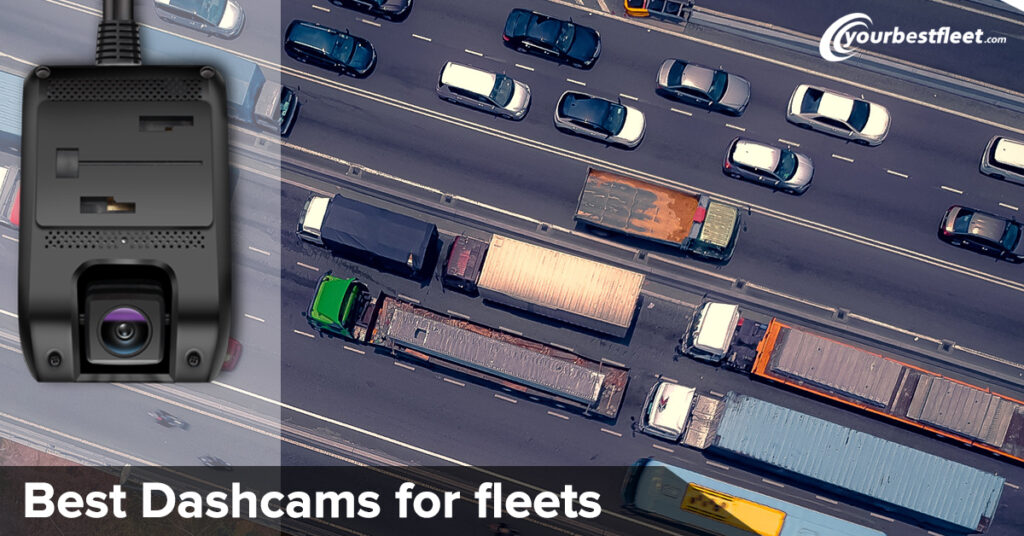As fleet owners and managers, the safety of your vehicles and drivers is vital for smooth and productive operations. Your responsibilities extend beyond your office and fleet yard premises. You must have complete visibility into where all your assets are at any given time. Achieving this manually is nearly impossible, so you need high-performing fleet tracking and management tools with best dashcams for fleets.
The dashcams are surveillance cameras that you can mount to the windshield or dashboard of trucks to record everything that happens on the road and the driving behavior. It is an effective way to enhance the visibility of surroundings and get an idea about potential risks.
A dashcam has a lot of benefits to offer apart from monitoring your driver’s safety and your truck’s performance on the road. Various features of the dashcam make it a reliable safety tool for fleet operations. This article will discuss how these features meet the business requirements that can guide you in selecting the best dashcams for your fleet.
Benefits of Dashcams
As a fleet business owner, you can achieve several benefits from dashcams that can help you defend against any fraud attempts on your business, keep your trucks safe and your drivers accountable, or protect your vehicles from accidental damages.
It is worthwhile to equip your fleet vehicles with in-car video cameras and get peace of mind. Some of the features of das cameras most relevant for your fleet operations are as follows:
- Dashcams can record incidents around the vehicle while on the move and when parked. These surveillance cameras can detect any potential risks on the road and guide drivers with visual and audio alerts, to maintain safety practices and enhance driving performance.
- One of the significant benefits of dashcams is transparency. The driver-facing camera monitors the driving behavior and generates immediate alerts if any reckless behavior is detected. Dashcam thus serves as an effective safety tool for commercial fleets by reducing the chances of accidents.
- Your driver may get involved in an accident, and you suffer fraudulent claims harassing your driver. The cameras produce reliable visual evidence with an unbiased view of events. It can prove the drivers’ innocence and also facilitate settling insurance claims.
- Dashcam captures crucial visual information about vehicles and drivers with real-time recordings of events. You can use a dashcam to identify the culprit in an accident, damage, theft, or tampering with your vehicles.
- Cameras paired with an existing fleet management system allow for providing critical visual references of routes, speed, location, and driver behavior throughout the trip.
- The advanced cameras with high-resolution imaging feature capture images with clarity even under poor lighting and adverse weather conditions, using night vision technology.
How to Select the Best Dashcams For Fleets
Dashcam for commercial fleets has various features that offer reliable solutions to fleet operators and owners for meeting their specific needs. You can comprehensively visualize the vehicle and surroundings and make informed decisions.
These cameras capture and auto-upload video footage, helping you review and analyze driving performance. The configurations vary widely to suit the specific requirements of fleet operators. Here, we will discuss some crucial features that guide you in selecting the best dashcam matching your business requirements.
Single or Multi-channel
The camera can be a single channel, meaning a single front camera exists. Dual or multi-channel settings allow installing front and rear cameras for a better overall view of the truck. A driver-facing camera is an important option for monitoring driving behavior and taking appropriate actions for any risky or unsafe practices.
Field of View
The field of view defines the area’s size for capturing images on the road ahead and around the vehicle. A larger field of view gives better visibility of incidents around the truck. Some cameras allow capturing a 360-degree view of the surroundings. It is crucial to guide drivers while taking steep turns or changing lanes.
Resolution
It is always desirable for dashcams to provide excellent image quality to view the road ahead and signals more clearly and distinctly. The higher the camera resolution, the sharper the image, with more details. It gives you a precise video where you can identify license plates and other elements, even from a distance. This high-definition footage produces reliable evidence with all details if your vehicle gets in an accident or trouble.
Harsh Event Detection
The advanced dashcams have built-in sensors that detect harsh driving activity and send alerts to the driver to control the behavior. The camera guides drivers to avoid potentially dangerous situations by following safety procedures and minimizing the chances of accidents.
Storage of data
The camera captures and saves the video in internal memory or a separate SD card. The high-definition images and videos require more storage space, so dashcams need adequate storage capacity and should support external SD cards to enhance storage capacity as per requirement. It ensures the saving of multiple image files that you can access for current and future use.
Automatic Alerts
The advanced features allow dashcams to generate automatic alerts when there are potential safety hazards like lane change without indicators, chances of a collision, slippery roads, etc. The AI-enabled sensor detects the potential danger and immediately sends the driver an audio alert to enable better control over the vehicle.
Night Vision
It is a feature that allows image recording during the night or under low light conditions. It is especially crucial for trucks operating at night or traveling through unfavorable weather conditions.
Parking Mode
It is an additional feature that enables you to protect your vehicle while parked. The cameras operating in parking mode can detect any movement or shock and immediately starts recording the incident around the truck. This footage can be a great aid in detecting any attempt of theft, hit and run, or vandalism.
Remote Access
Devices with remote access allow you to check camera settings and review footage as per requirements. Internet connectivity allows the uploading of videos to cloud storage accessible through user-friendly phone apps. It is a very convenient mode of controlling and utilizing the camera features.
Matrack Dashcam

Matrack Dashcam is one of the most suitable safety devices for your fleets. It has dual-facing cameras that enhance visibility and make drivers cautious in potentially dangerous situations. The dashcam has both lane and driver-facing cameras and gives the most comprehensive vision of the surroundings.
The audio alerts notify the driver whenever it identifies any risky driving behaviors, fatigue, or distractions. Warning systems like lane departure and forward collision alerts help drivers to practice safe driving and proactively avoid accidents.
It uploads video footage of an event to the cloud platform that you can access for analysis of driving behaviors and risk assessment. The high-resolution camera gives you clear and vivid video footage that provides solid evidence in case of accidents or damages.
These cameras are appropriate with parking surveillance mode and record the incident around the vehicle by sensing any movement or impact when it is at rest. The night vision facility allows recording videos under poor lighting conditions, thus improving the device’s reliability.
The GPS-enabled geofencing and real-time tracking enable you to keep a constant eye on your vehicle location and movements, thus ensuring prompt actions and informed decisions.
Conclusion
You can efficiently manage the safety of your vehicles with dashboard cameras as it increases the visibility of truck and drivers’ performance. It ensures protection from false accident reporting, faster insurance claims, better driving practices, and the assessment of potential risks.
In this article, we have highlighted some significant dashcam features like high-quality images, timely alerts, location tracking, constant surveillance, and remote access to videos for preview and analysis.
This article will guide fleet managers in finding an ideal dashcam based on the relevant features to keep fleet operations safe, reliable, and efficient.
Frequently Asked Questions
1. Why are dashcams important for fleets?
Ans. Dashcams can provide valuable evidence in the event of an accident or other incident, and can also help fleet managers monitor driver behavior and improve safety.
2. What are some key factors to consider when selecting dashcams for fleets?
Ans. Some key factors to consider include video quality, field of view, storage capacity, durability, and ease of installation and use.
3. What is video quality and why is it important?
Ans. Video quality refers to the resolution and clarity of the video footage recorded by the dashcam. Higher video quality can provide clearer and more detailed footage, which can be especially important for identifying license plates and other details in the event of an accident or other incident.
4. What is storage capacity and why is it important?
Ans. Storage capacity refers to the amount of video footage that can be stored on the dashcam’s memory card or other storage device. Adequate storage capacity is important to ensure that important footage is not overwritten or lost due to insufficient space.
5. What is the ease of installation and use and why is it important?
Ans. Ease of installation and use refers to the ease with which the dashcam can be installed in the vehicle and configured and operated by fleet personnel. A dashcam that is easy to install and use can save time and reduce the risk of errors or issues during setup or operation.
6. Can dashcams be used for more than just recording footage?
Ans. Yes, some dashcams come with additional features such as GPS tracking, driver coaching tools, and remote access and monitoring capabilities, which can provide additional benefits for fleet managers and drivers.
James Johnson is a former truck driver who now works as a writer, specializing in the trucking industry. With over 15 years of experience on the road, James has a unique perspective on the challenges and opportunities faced by truck drivers and the trucking industry as a whole. His writing focuses on issues such as safety, regulation, and the latest industry trends. His work has been featured in several trucking publications and he has received recognition for his contributions to the industry. In his free time, James still enjoys being around trucks and often attends truck shows and other industry events.


